LSE Festival Exhibition
The exhibition wall at the LSE Festival 2025 presented the project Children's visions of digital futures. The global research project was co-designed with 18 children from 14 countries. Through speculative futures workshops, children (ages 13–17) explored what a sustainable, empowering and equitable digital world could look like over the next 25 years. Children were asked to envision this future in diverse settings.
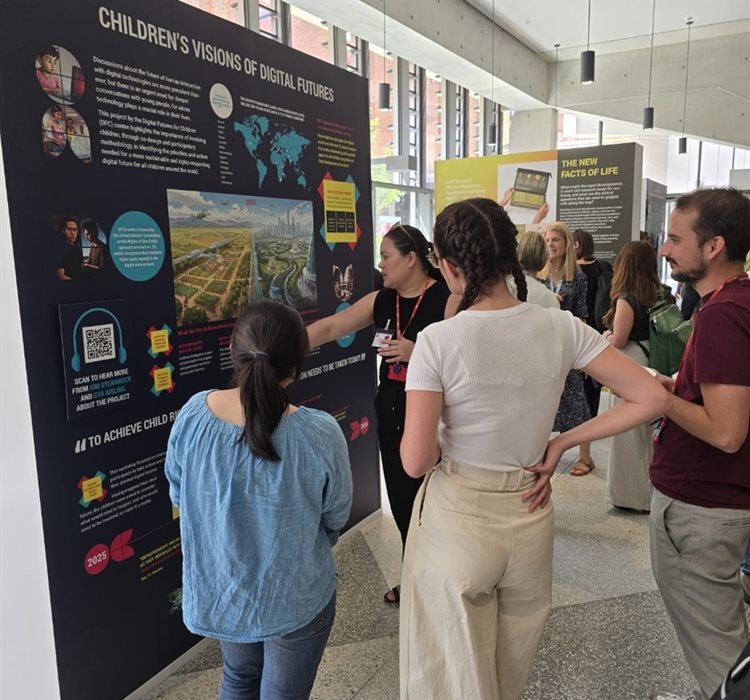 Poster exhibition: Children's visions of digital futures.
Poster exhibition: Children's visions of digital futures.
LSE family day: Children's digital futures bazaar
The DFC team (Mariya, Gazal, Marisa and Kim) welcomed 50 children aged 6-16 to three morning sessions at the LSE festival family day. The bazaar featured different workshops: build your own future digital project, imagine your ideal digital future and time capsule.
Build your own future digital product
Children were invited to imagine, design and build their own future digital product or app to improve the lives of children around the world. The DFC provided prompts, characters and craft materials to first sketch and then construct physical prototypes of their ideas. The activity encouraged creativity and empathy by asking children to consider what life might be like in the future and how digital tools could benefit them.
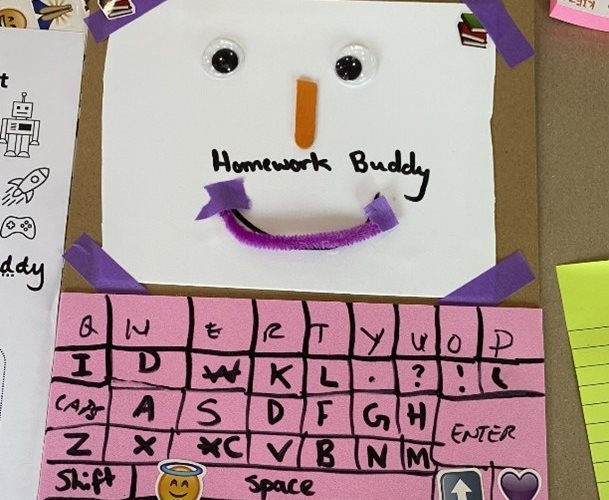 'Homework buddy' helps with schoolwork and comes with funny voices.
'Homework buddy' helps with schoolwork and comes with funny voices.
Imagine your ideal digital future
This activity, geared towards older children, invited participants to co-create a vision of their ideal digital future, based on foresight methodology. Using two boards with prompts and discussion, the children identified: what they wanted to see in their ideal digital future; the key technologies, experiences and actors that could shape the future digital world and what could enable or block positive development. Children then left messages for adults and decision-makers about what actions are needed to make these futures possible.
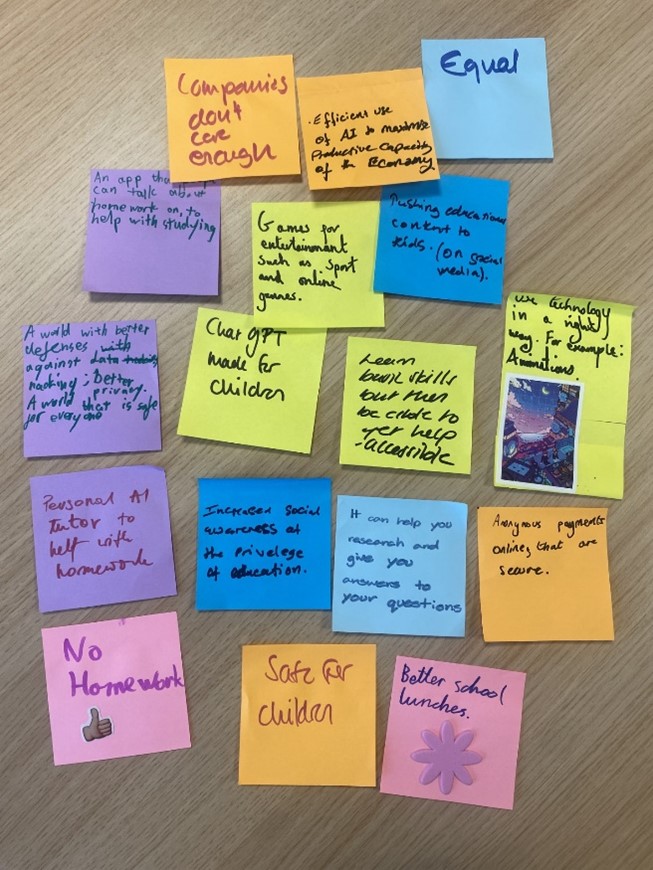 Comments for adults and decision makers, ranging from "No homework" to "better defenses against data hacking".
Comments for adults and decision makers, ranging from "No homework" to "better defenses against data hacking".
Time capsule
The activity firstly required participants to arrange a timeline of digital inventions, reflecting on how digital innovation has shaped history and imagining what may emerge in the near future.The second part of the activity invited children and parents to write or draw messages to the children of the future, highlighting the positive aspects of today's digital world and what needs to change. The activity closed with an invitation to share their hopes for a better digital future on a message board for decision-makers.
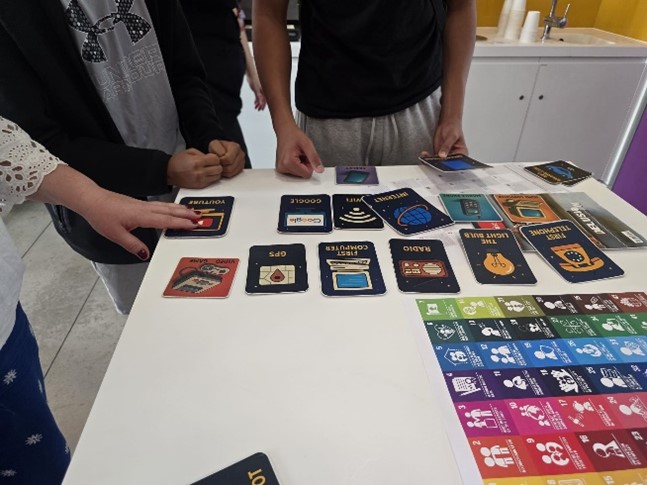 Timeline activity: Children putting each technological invention in order.
Timeline activity: Children putting each technological invention in order.
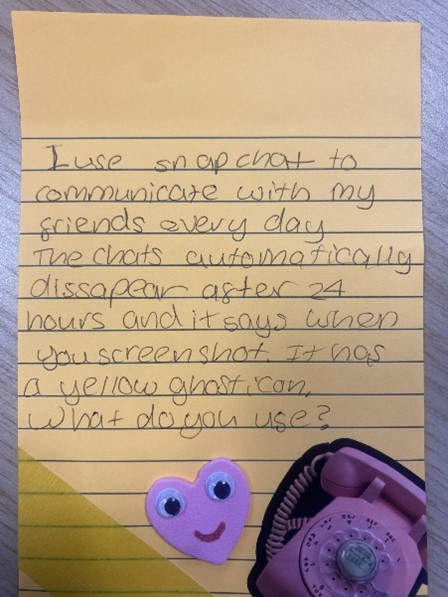 In answering 'What do you want to tell the future that is good in the digital present?' one child writes about their use of Snapchat.
In answering 'What do you want to tell the future that is good in the digital present?' one child writes about their use of Snapchat.
Empowerment, safety and equity: children's visions of rights-respecting digital futures
As part of the LSE Festival 2025, the DFC hosted an interactive event which showcased Children's visions of digital futures a global research project wherein 5Rights Global Youth Ambassadors Aisling (Ireland), Filippos (Greece) and Srishti (USA) presented their priorities and reflections from their work. The ambassadors posed questions to an expert panel, including leaders in policy, immersive storytelling, child safety and regulation, sparking a dialogue on how to build digital futures that uphold children's rights globally.
Our panel brought together leading experts in children's digital rights, safety and innovation. Dr. Sakshi Ghai is a behavioural scientist at LSE whose research focuses on how technologies like AI and social media impact vulnerable youth, with a commitment to global research equity. Professor Dylan Yamada-Rice is an expert in immersive storytelling and children's media, exploring digital play across platforms such as VR, AR and television. Adam Ingle, from the LEGO Group, leads on digital policy, ensuring safe and privacy-respecting digital experiences for children, drawing on his prior work at the UK's data regulator. Michael Murray, from the ICO, develops policy on children's data rights and age-appropriate design, and contributes internationally through work with UNICEF and other global partners.
Filippos reflected that digital transformation is fundamentally reshaping what it means to grow up, influencing how young people learn, connect and see themselves, often without their input in the process. While innovation brings benefits, it must not come at the cost of children's privacy, safety, or agency.
"Like Jules Verne imagined futures before they existed, young people today are imagining the kind of digital world we want to live in."
Srishti reflected that young people across the globe share a common vision: digital spaces that are both safe and empowering, where no child is excluded due to geography or resources. She described how through collaborative activities and diverse storytelling, youth ambassadors identified critical needs, like responsible AI, digital literacy and cultural inclusion, as essential to building child-centred digital futures.
"While our contexts differ, our hopes are the same: we all want safe digital environments and the freedom to explore new frontiers."
Aisling reflected that young people around the world share growing concerns about AI, privacy and unequal access to digital tools, highlighting the urgency for inclusive, future-focused regulation. She noted that when imagining contrasting futures in the workshops, youth ambassadors underscored the need for global cooperation and swift policy action to ensure that digital environments are equitable and accessible to all, regardless of geography or identity.
"In LSE language, data = capital; if you don't own it, you can't leverage it. Our haste to adapt latest technologies like AI needs to be met with equally as fast policy, driven not by current problems but by future proofing."
Questions asked by the youth ambassadors to the experts:
Directed to Adam Ingle (LEGO, Digital Policy and Innovation)
- How do you envision the digital future, and how will you include children in shaping it?
- As you develop AI-driven play experiences, how do you balance creative exploration with risks like bias and privacy?
- How have children's rights frameworks influenced your design approach, and what have you learned from applying them?
Directed to Dr. Sakshi Ghai (LSE)
- Based on your work on digital divides, how can we design safety interventions that empower children in low-resource settings?
- How can children's voices inform culturally sensitive protection features in digital environments?
- Given regulatory disparities between the Global North and South, how can we ensure progressive digital standards apply equally worldwide?
Directed to Professor Dylan Yamada-Rice (Immersive Storytelling, University of Plymouth)
- How do you guide children to balance creativity with safety and personal agency when imagining digital futures?
- Which storytelling or immersive techniques best help children articulate visions for safe and empowering digital spaces?
Directed to Michael Murray (ICO, Regulation and Children's Privacy)
- What guiding principles should shape the future evolution of the Age-Appropriate Design Code to strengthen children's data rights and autonomy?
- How can "privacy by design" be embedded meaningfully in digital platforms to enhance child control and regulatory trust?
- In light of anti-inclusion movements, how can governments protect vulnerable communities online while drafting inclusive regulations?
- How can regulators maintain control over powerful multinational tech corporations that operate beyond national jurisdictions?
Watch the video of the event here.
Event report by Kim R. Sylwander